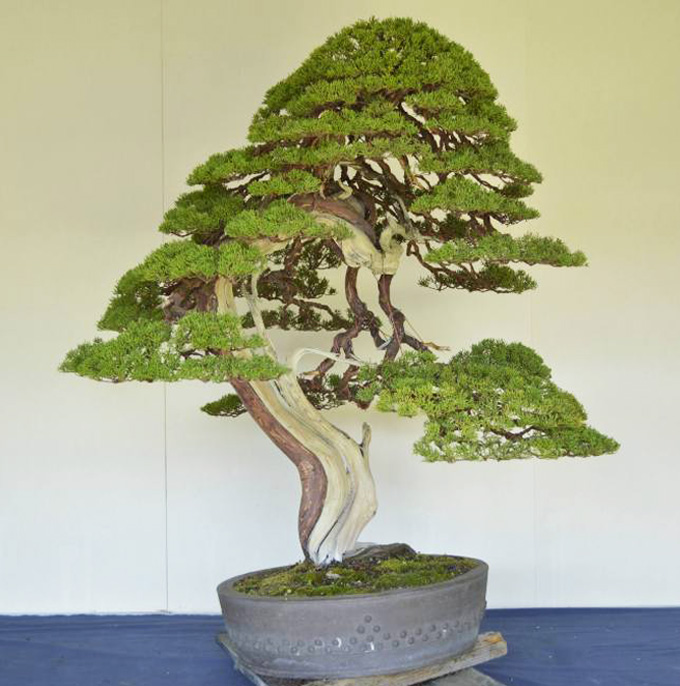 After. This masterpiece Itoigawa Shimpaku was recently restyled by Bjorn Bjorholm at Keiichi Fujikawa’s Kouka-en Bonsai Nursery in Ikeda City, Japan, where Bjorn is currently an apprentice. The photo is from a post on Bjorn’s Bjorvala Bonsai Studio blog, as are all the photos in this post.
After. This masterpiece Itoigawa Shimpaku was recently restyled by Bjorn Bjorholm at Keiichi Fujikawa’s Kouka-en Bonsai Nursery in Ikeda City, Japan, where Bjorn is currently an apprentice. The photo is from a post on Bjorn’s Bjorvala Bonsai Studio blog, as are all the photos in this post.
The Biggest Loser
In Bjorn’s own words…
“This massive Itoigawa Shimpaku has a long history as a bonsai. It was first shown in the Kokufu-ten about 35 years ago, back in the days before the boom in major refinement techniques and quality occurred. Since then, it was purchased by several different owners and has been in the collection of its current owner for about 20 years. During that period, this particular client has tried to show it in the Kokufu-ten again on three separate occasions, and each time the tree has failed to cut the mustard, so-to-speak. The owner recently brought the impressive juniper to us at Kouka-en for a major restyling and to see if, perhaps, we might be able to transform it once again into a Kokufu-ten-worthy bonsai…” (please visit Bjorn’s blog for the rest of what he has to say about this tree).
 Before. To paraphrase Bjorn, this tree arrived at Kouka-en after being over-watered, overfed and overgrown.
Before. To paraphrase Bjorn, this tree arrived at Kouka-en after being over-watered, overfed and overgrown.
Fertilizing for health and ramification. What does it mean to overfeed a bonsai? I (Wayne, not Bjorn) should say something here, as I’ve put a lot of energy into encouraging our readers to fertilize more, rather than less. To clarify, we need to make a distinction between older well-established trees and younger less developed trees.
With older bonsai, once the trunk and branches are well developed, two primary concerns are the health of the tree and the continued development of fine branching (ramification). If you fertilize too much at this stage, the fine branching grows too fast, with the result being undesirable thickness and internodes that are too long. So you want to slow the feeding down to just enough to keep the tree healthy and to promote tight ramification.
With younger trees, heavier fertilizing helps promote faster growth which can result in increased trunk girth and the development of strong primary branching. Though there much more that can be said, and, as with most everything, finding the proper balance between too much and not enough is key.
 This closer look gives you a pretty good view of how well this tree is ramified. If you look closely, you can follow the branching from primary, to secondary, to tertiary and so forth. Though conifers aren’t usually as highly ramified as the most developed deciduous trees, still, ramification is critical if you want top-notch conifer bonsai.
This closer look gives you a pretty good view of how well this tree is ramified. If you look closely, you can follow the branching from primary, to secondary, to tertiary and so forth. Though conifers aren’t usually as highly ramified as the most developed deciduous trees, still, ramification is critical if you want top-notch conifer bonsai.
For a more photos and insight into the process from before to after, you can visit Bjorvala Bonsai Studio.

Wayne,
Question: I have numerous trees in varying stages of development. I use full strength liquid fertilizers such as fish emulsion, Dynagro and Miracid as per manufacturers labelling. I fertilize all of my trees bimonthly. By over fertilization are you suggesting fertilizing less often than this or at a lesser strength for more advanced trees? Thanks!
Owen
Hi Owen,
I think over fertilizing would be either too much at any given time or too much too often. Especially with strong liquid soluble ferts. But because there are almost as many fertilizing plans as there are soil mixes, I’ll just tell you what I do:
I use very diluted (one cap per 2 gallons) liquid fert (BonsaiPro) on my younger trees with every second or third watering. I also add moderate amounts of Green Dream about every 2 weeks (that’s not the way Colin recommends, but it makes me happy). I also sometimes use Microplus (or liquid seaweed) and very occasionally 0-10-10. And, I sometimes use a little fish and experiment with other fertilizers. In general I’d say I emphasize frequency so there are always plenty of nutrients available, but with fairly mild fertilizers.
With older trees, I use liquid only occasionally (every 3 weeks or so) and slow the Green Dream down to about half to one third speed. I might still use some Microplus or seaweed and fish on occasion, but not much.
However, most of my experience is with younger and intermediate aged trees. When it comes to very old specimen trees, the people with the most experience are the Japanese (and Chinese). I think you might want to check with Michael Hagedorn, Peter Tea, Bjorn or some of the other people who have worked in Japan to get their insights. And then there are the old back issues of Bonsai Today.